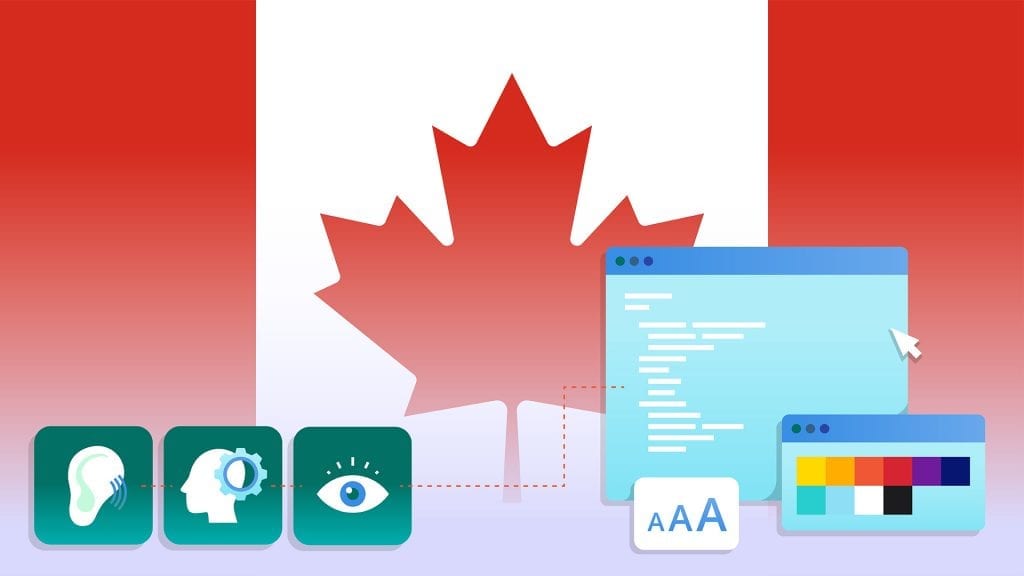All You Need to Know: Web Accessibility Laws in Canada
What’s required to meet accessibility standards in Canada? Here’s everything you need to know to avoid accessibility violations.

What’s required to meet accessibility standards in Canada? Here’s everything you need to know to avoid accessibility violations.
What Are Web Accessibility Laws?
The Canadian Human Rights Act of 1977 was enacted to prohibit discrimination in many forms. While it did not specifically address accessibility requirements, it has been interpreted as such to require websites to make sure that organizations provide accessible content to persons with disabilities. This includes employment listings and access to other web content.
Web accessibility standards are addressed directly in the Standard on Web Accessibility created in 2011.
Canada also supports the United Nation’s Convention on the Rights of Persons with Disabilities, enacted in 2010. It stipulates an equal basis and right of equal access without discrimination.
The Accessible Canada Act was passed to identify, remove, and prevent barriers to accessibility for persons with disabilities. Also known as the Act to Ensure a Barrier-Free Canada, it mandates compliance for digital content and tech for Parliament, the Government of Canada, and federally-regulated organizations in the private sector. This includes sectors such as banking, telecommunications, and transportation industries.
Web accessibility standards are also addressed in the Policy on the Duty to Accommodate Person with Disabilities in the Federal Public Service by requiring employment opportunities in the federal Public Service to be accessible to those with disabilities.
Other Federal Laws Governing Accessibility
Other federal laws may apply, including:
- The Canadian Charter of Rights and Freedoms
- The Employment Equity Act
Provincial Laws Governing Accessibility
Each province in Canada has its own version of the Human Rights Act. In addition, several provinces have enacted accessibility legislation, including:
- Quebec’s Respecting Equal Access to Employment in Public Bodies
- The Accessibility for Ontarians with Disabilities Act (AODA)
- The Accessibility for Manitobans Act
- The Nova Scotia Accessibility Act
Who Does Web Accessibility Law Benefit?
As part of the development process for the Accessible Canada Act, the government of Canada surveyed its population. It found that 22% of the population, or more than 6 million Canadians aged 15 or older, identified as disabled. Those with disabilities have far lower employment rates, earn less than those without disabilities, and are more likely to live in poverty.
The definition of disability is less stringent in Canada than in some other countries. For example, those with addictions may qualify for disability benefits. If any of these conditions impact the quality of life, under certain situations, Canada web accessibility standards may apply:
- Addictions
- ADHD
- Alzheimer’s
- Arthritis
- Bi-Polar Disorder
- COPD
- Crohn’s Disease
- Depression
- Diabetes
- Difficulty Walking
- Fibromyalgia
- IBS
- Learning Disabilities
- PTSD
Who Is Required to Follow Canadian Web Accessibility Laws?
Government agencies, businesses, and organizations are all required to provide equal access to users with disabilities.
Most laws and regulations give broad descriptions of what constitutes discrimination or creates barriers for the disabled. Outside of general terms, the do not list the steps or practices organizations need to take to meet the web accessibility standards for businesses. The Canadian Accessibility Standards Development Organization has been formed to develop web accessibility standards for organizations.
However, web content accessibility guidelines and recommendations published by the World Wide Web Consortium (W3C) have been accepted as best practices for website developers and User Experience (UX) developers. This accessibility standard, the Web Content Accessibility Guidelines (WCAG) has been adopted by countries throughout the world as a way to comply with legal accessibility requirements.
Canada’s Standard of Web Accessibility (2011) specifically mandates that government websites meet accessibility web standards by conforming to WCAG requirements.
Remember that section 1.2.2 of the WCAG guidelines requires synchronized captions for all audio and video, which you can get from Rev.com
Get Captions & subtitles for videos to improve Accessibility
How Are Web Accessibility Laws Enforced?
The Accessible Canada Act created two specific positions that have enforcement obligations. The Accessibility Commissioner and Chief Accessibility Officer. The Commissioner has the authority to fine organizations up to $250,000 for each violation.
The Commissioner’s office is tasked with investigating complaints, assessing fines, and ordering corrective measures.
How to Comply with Canada Web Accessibility Standards
Following the web accessibility standards laid out in the Web Content Accessibility Guidelines (WCAG) from WC3 are considered the best way to comply with Canadian web accessibility laws pending the results of the Canadian Accessibility Standards Development Organization.
The WCAG recommends specific ways to make online content more accessible to those with disabilities. It covers four main areas for websites:
- Perceivable - All users, including those with impaired vision, should be able to see and read your website.
- Operable - Websites should be responsive and easy to navigate for all users across multiple browsers and mobile devices
- Understandable - Websites should be organized in a way that’s easy to use and use language that most customers can understand.
- Robust - Websites should integrate with tools (Assistive Technology or AT) that are used by users with disabilities.
The WCAG 2.1 Guidelines contain a comprehensive list of items for businesses, User Experience (UX) designers, and web designers. To check whether your website is compliant, here is a list of the online tools available to check for compliance.
Get Captions & subtitles for videos to improve Accessibility
Subscribe to The Rev Blog
Sign up to get Rev content delivered straight to your inbox.



